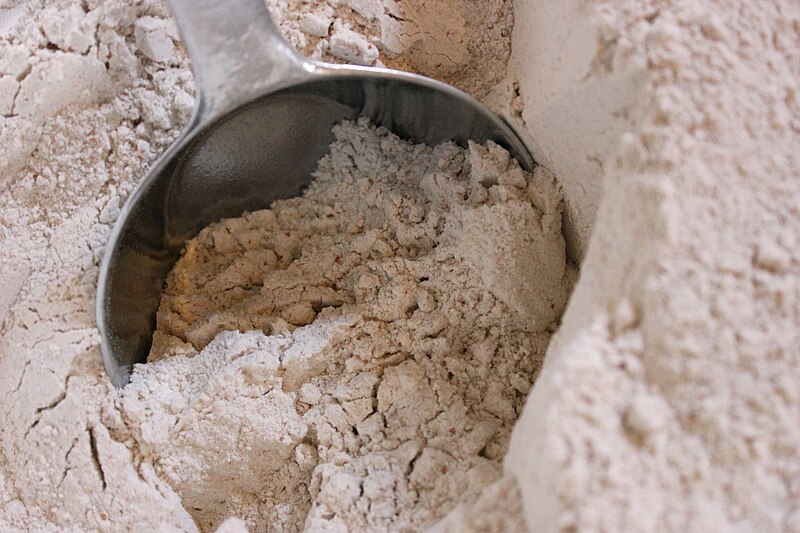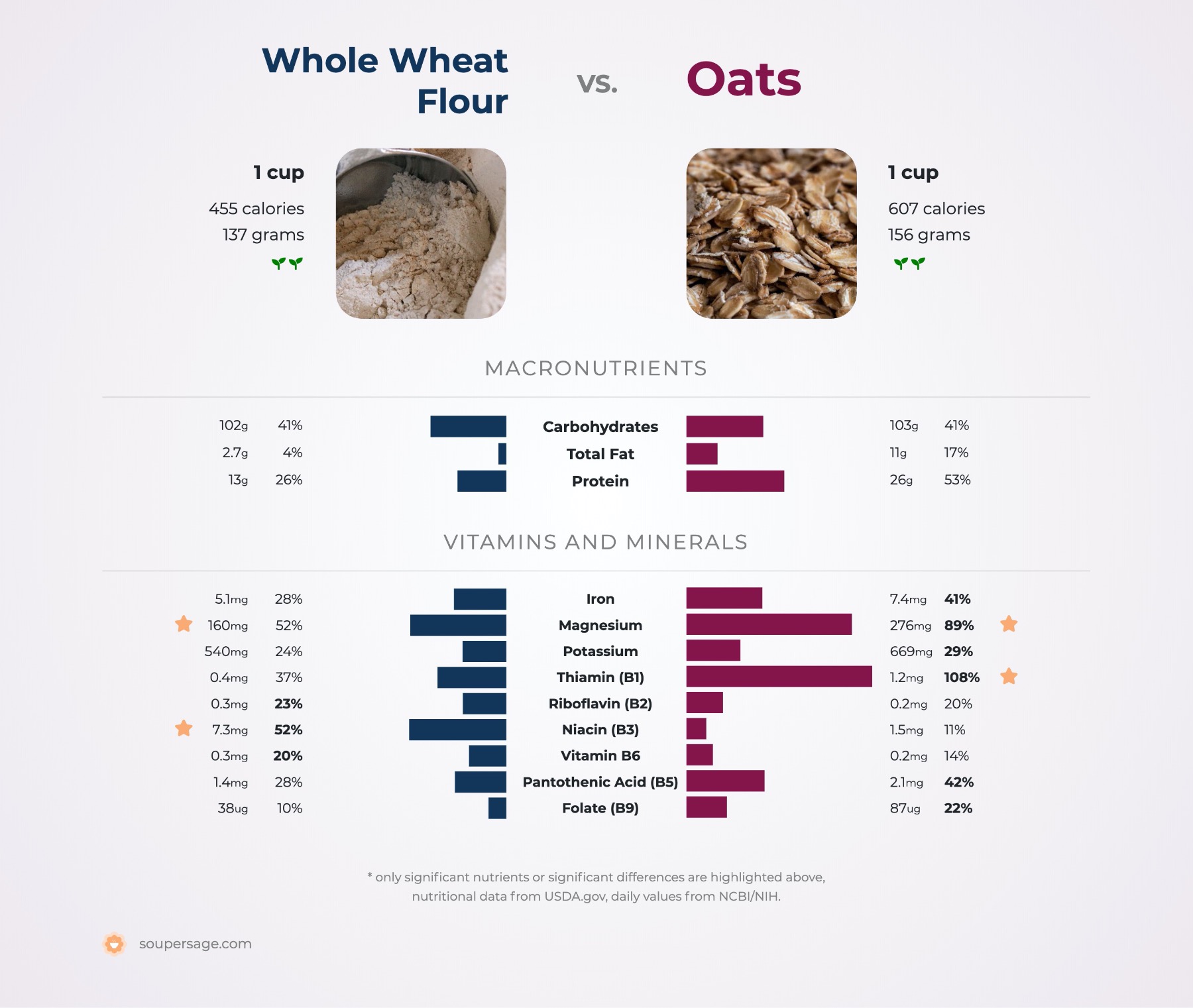Oats vs. Whole Wheat Flour
Nutrition comparison of Oats and Whole Wheat Flour
Ever wonder how your favorite foods stack up against each other in terms of nutrition?
We compared the nutritional contents of
oats
versus
whole wheat flour
(100g each)
below using 2020 USDA and NIH data[1].
For a quick recap of significant nutrients and differences in oats and whole wheat flour:
- Both whole wheat flour and oats are high in calories, carbohydrates, dietary fiber, iron, potassium and protein.
- Oat has more thiamin, however, whole wheat flour contains more niacin.
- Oat is a great source of calcium.
USDA sources for nutritional information: Oats (Oats (Includes foods for USDA's Food Distribution Program)) and Whole Wheat Flour (Wheat flour, whole-grain, soft wheat) . Have a correction or suggestions? Shoot us an email.
Calories and Carbs
calories
Both whole wheat flour and oats are high in calories. Oat has 17% more calories than whole wheat flour - whole wheat flour has 332 calories per 100 grams and oat has 389 calories.
For macronutrient ratios, oats is heavier in protein, lighter in carbs and heavier in fat compared to whole wheat flour per calorie. Oats has a macronutrient ratio of 17:67:16 and for whole wheat flour, 11:84:5 for protein, carbohydrates and fat from calories.
Macro Ratios from Calories:
| Oats | Whole Wheat Flour | |
|---|---|---|
| Protein | 17% | 11% |
| Carbohydrates | 67% | 84% |
| Fat | 16% | 5% |
| Alcohol | ~ | ~ |
carbohydrates
Both whole wheat flour and oats are high in carbohydrates. Whole wheat flour has 12% more carbohydrates than oat - whole wheat flour has 74.5g of total carbs per 100 grams and oat has 66.3g of carbohydrates.
dietary fiber
Both whole wheat flour and oats are high in dietary fiber. Whole wheat flour has 24% more dietary fiber than oat - whole wheat flour has 13.1g of dietary fiber per 100 grams and oat has 10.6g of dietary fiber.
sugar
Oat has less sugar than whole wheat flour - whole wheat flour has 1g of sugar per 100 grams and oat does not contain significant amounts.
Protein
protein
Both whole wheat flour and oats are high in protein. Oat has 76% more protein than whole wheat flour - whole wheat flour has 9.6g of protein per 100 grams and oat has 16.9g of protein.
Fat
saturated fat
Whole wheat flour and oats contain similar amounts of saturated fat - whole wheat flour has 0.43g of saturated fat per 100 grams and oat has 1.2g of saturated fat.
Vitamins
Vitamin A
Whole wheat flour and oats contain similar amounts of Vitamin A - whole wheat flour has 2.7ug of Vitamin A per 100 grams and oat does not contain significant amounts.
Vitamin E
Whole wheat flour has more Vitamin E than oat - whole wheat flour has 0.53mg of Vitamin E per 100 grams and oat does not contain significant amounts.
Vitamin K
Whole wheat flour and oats contain similar amounts of Vitamin K - whole wheat flour has 1.9ug of Vitamin K per 100 grams and oat does not contain significant amounts.
The B Vitamins
Oat has more thiamin, however, whole wheat flour contains more niacin. Both oats and whole wheat flour contain significant amounts of riboflavin, pantothenic acid, Vitamin B6 and folate.
| Oats | Whole Wheat Flour | |
|---|---|---|
| Thiamin | 0.763 MG | 0.297 MG |
| Riboflavin | 0.139 MG | 0.188 MG |
| Niacin | 0.961 MG | 5.347 MG |
| Pantothenic acid | 1.349 MG | 1.011 MG |
| Vitamin B6 | 0.119 MG | 0.191 MG |
| Folate | 56 UG | 28 UG |
Minerals
calcium
Oat is a great source of calcium and it has 64% more calcium than whole wheat flour - whole wheat flour has 33mg of calcium per 100 grams and oat has 54mg of calcium.
iron
Both whole wheat flour and oats are high in iron. Oat has 27% more iron than whole wheat flour - whole wheat flour has 3.7mg of iron per 100 grams and oat has 4.7mg of iron.
potassium
Both whole wheat flour and oats are high in potassium. Whole wheat flour is very similar to whole wheat flour for potassium - whole wheat flour has 394mg of potassium per 100 grams and oat has 429mg of potassium.
Customize your serving size
The comparison below is by common portions, e.g. cups, packages. You can also see a more concrete comparison by weight at equal weight (by grams) comparison.
Note: The specific food items compared are: Oats (Oats (Includes foods for USDA's Food Distribution Program)) and Whole Wheat Flour (Wheat flour, whole-grain, soft wheat) .
Oats g
()
|
Daily Values (%) |
Whole Wheat Flour g
()
|
|||||
|---|---|---|---|---|---|---|---|
| KCAL % |
|
5% | calories | 5% |
|
KCAL % | |
| G % |
|
5% | carbohydrates | 5% |
|
G % | |
| G % |
|
5% | dietary fiber | 5% |
|
G % | |
| G | 5% | sugar | 5% | G | |||
| G % |
|
5% | total fat | 5% |
|
G % | |
| G % |
|
5% | saturated fat | 5% |
|
G % | |
| G | 5% | monounsaturated fat | 5% | G | |||
| G | 5% | polyunsaturated fat | 5% | G | |||
| G | 5% | trans fat | 5% | G | |||
| MG | 5% | cholesterol | 5% | MG | |||
| MG % |
|
5% | sodium | 5% |
|
MG % | |
| 5% | Vitamins and Minerals | 5% | |||||
| UG % |
|
5% | Vitamin A | 5% |
|
UG % | |
| MG % |
|
5% | Vitamin C | 5% |
|
MG % | |
| IU % |
|
5% | Vitamin D | 5% |
|
IU % | |
| MG % |
|
5% | calcium | 5% |
|
MG % | |
| MG % |
|
5% | iron | 5% |
|
MG % | |
| MG % |
|
5% | magnesium | 5% |
|
MG % | |
| MG % |
|
5% | potassium | 5% |
|
MG % | |
| MG % |
|
5% | thiamin (Vit B1) | 5% |
|
MG % | |
| MG % |
|
5% | riboflavin (Vit B2) | 5% |
|
MG % | |
| MG % |
|
5% | niacin (Vit B3) | 5% |
|
MG % | |
| MG % |
|
5% | Vitamin B6 | 5% |
|
MG % | |
| MG % |
|
5% | pantothenic acid (Vit B5) | 5% |
|
MG % | |
| UG % |
|
5% | folate (Vit B9) | 5% |
|
UG % | |
| UG % |
|
5% | Vitamin B12 | 5% |
|
UG % | |
| MG % |
|
5% | Vitamin E | 5% |
|
MG % | |
| UG % |
|
5% | Vitamin K | 5% |
|
UG % | |
| G % |
|
5% | protein | 5% |
|
G % | |
| UG % |
|
5% | biotin (Vit B7) | 5% |
|
UG % | |
| MG % |
|
5% | choline | 5% |
|
MG % | |
| MG % |
|
5% | chlorine | 5% |
|
MG % | |
| UG % |
|
5% | chromium | 5% |
|
UG % | |
| MG % |
|
5% | copper | 5% |
|
MG % | |
| UG % |
|
5% | fluoride | 5% |
|
UG % | |
| UG % |
|
5% | iodine | 5% |
|
UG % | |
| MG % |
|
5% | manganese | 5% |
|
MG % | |
| UG % |
|
5% | molybdenum | 5% |
|
UG % | |
| MG % |
|
5% | phosphorus | 5% |
|
MG % | |
| UG % |
|
5% | selenium | 5% |
|
UG % | |
| MG % |
|
5% | zinc | 5% |
|
MG % | |
| G | 5% | Water | 5% | G | |||
| G | 5% | Starch | 5% | G | |||
| G | 5% | Alcohol | 5% | G | |||
FAQ
Does whole wheat flour or oats contain more calories in 100 grams?Both whole wheat flour and oats are high in calories. Oat has 20% more calories than whole wheat flour - whole wheat flour has 332 calories in 100g and oat has 389 calories.
Does whole wheat flour or oats have more carbohydrates?
By weight, both whole wheat flour and oats are high in carbohydrates. whole wheat flour has 10% more carbohydrates than oat - whole wheat flour has 74.5g of carbs for 100g and oat has 66.3g of carbohydrates.
Does whole wheat flour or oats contain more iron?
Both whole wheat flour and oats are high in iron. Oat has 30% more iron than whole wheat flour - whole wheat flour has 3.7mg of iron in 100 grams and oat has 4.7mg of iron.
Does whole wheat flour or oats contain more potassium?
Both whole wheat flour and oats are high in potassium. Whole wheat flour is very similar to whole wheat flour for potassium - whole wheat flour has 394mg of potassium in 100 grams and oat has 429mg of potassium.


